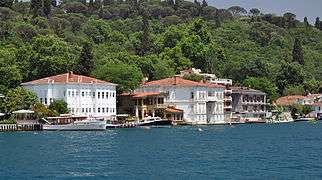Yalı

A yalı (Turkish: yalı, from Greek yiáli γιαλή (mod. γιαλός), literally "seashore, beach"[1][2]) is a house or mansion constructed at immediate waterside (almost exclusively seaside, particularly on the Bosphorus strait in Istanbul) and usually built with an architectural concept that takes into account the characteristics of the coastal location. A family who owned a waterside residence would spend some time in this usually secondary residence located at the sea shore, as opposed to the "konak" (mansion, aside from the term's use to refer to buildings with administrative functions) or the "köşk" (pavilion, often serving a determined practical purpose, such as hunting, or implying a temporary nature). Thus, going to the "yalı" acquired the sense of both going to the seaside and to the house situated there. In its contemporary sense, the term "yalı" is used primarily to denote the total amount of 620 waterside residences, mostly dating from the 19th century (some of them date from the 18th century, and some from the early 20th century), sprinkled along the Bosphorus in Istanbul. As such, they constitute one of the city's landmarks.
Finely worked wood was the predominant construction material chosen for yalıs, as it was for the large majority of traditional Turkish houses. Successive restorations often caused the wooden parts of the overall structure to be gradually reduced, but wood nevertheless remains the prominent and identifying material of historic yalıs. It is not uncommon for the most recently restored mansions to employ wood principally for external decoration purposes.
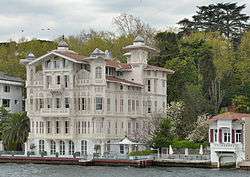
The oldest surviving yalı is the one built by the grand vizier Amcazade Köprülü Hüseyin Pasha (of the highly influent Köprülü family) in 1699 at the Kanlıca neighbourhood (within Beykoz district), on the Asiatic shores of the Bosphorus. From this yalı, the hall of audience (divanhane) and its immediate annexes have survived. On the opposite European shores, the oldest to remain is the "Şerifler Yalısı" in the Emirgan neighbourhood (within Sarıyer district), which was built in 1780 but bears the name of a later owner. The most expensive yalı is "Erbilgin Yalısı" located in Yeniköy, Istanbul. Forbes magazine listed "Erbilgin Yalısı" as the fifth most expensive house in the world with a price tag of $100 million.[3]
Cornucopia, a magazine about the arts, culture and history of Turkey, has a regular feature on the Bosphorus yalıs, their architecture and their interiors.[4] Notable inclusions have been the Yalı of Kıbrıslı Mehmed Emin Pasha,[5] the Yalı of Ethem Pertev,[6] the Yalı of Saffet Pasha,[7] and the Yalı of Zeki Pasha.[8]
Prices
Yalıs are known as the most expensive houses of Istanbul. There are also historical yalıs available for commercial lease. Some of the most expensive yalıs are as follows: Hekimbaşı Salih Efendi Yalısı ($185,000,000); Şehzade Burhaneddin Efendi Yalısı ($150,000,000); Tophane Müşiri Zeki Paşa Yalısı ($125,000,000); Kıbrıslı Mehmed Emin Paşa Yalısı ($120,000,000); Kont Ostrorog Yalısı ($105,000,000); Zarif Mustafa Paşa Yalısı ($70,000,000). The Sabancı family, which owns one of Turkey's largest industrial conglomerates, purchased the Ahmet Afif Paşa Yalısı in Yeniköy for 58,000,000 TL in 2009.[9][10]
Image gallery
 Ottoman era waterfront houses (yalı) on the Bosphorus.
Ottoman era waterfront houses (yalı) on the Bosphorus.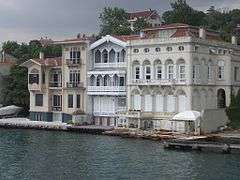 Ottoman era waterfront houses (yalı) on the Bosphorus.
Ottoman era waterfront houses (yalı) on the Bosphorus.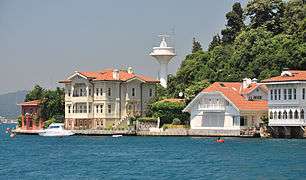
.jpg)



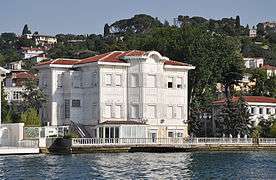


 Hekimbaşı Salih Efendi Yalısı in Kanlıca on the Bosphorus.
Hekimbaşı Salih Efendi Yalısı in Kanlıca on the Bosphorus.- Saffet Paşa Yalısı in Kanlıca on the Bosphorus.
_on_the_Bosphorus%2C_Turkey_001.jpg) Yalı of Ahmet Rasim Pasha in Kanlıca on the Bosphorus.
Yalı of Ahmet Rasim Pasha in Kanlıca on the Bosphorus.- Kanlıca, on the Bosphorus.
- Kanlıca, on the Bosphorus.
_in_Bebek%2C_Istanbul%2C_Turkey_001.jpg)
 Yalı of Count Ostrorog on the Bosphorus.
Yalı of Count Ostrorog on the Bosphorus.

- A yalı in Anadolu Kavağı on the Bosphorus.
- Anadoluhisarı, on the Bosphorus.
 Arnavutköy, on the Bosphorus.
Arnavutköy, on the Bosphorus.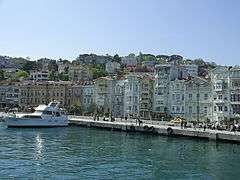 Arnavutköy, on the Bosphorus.
Arnavutköy, on the Bosphorus.
See also
References
| Wikimedia Commons has media related to Yalı. |
- ↑ TDK Online - Yalı entry
- ↑ Nisanyan.com - Etymological Dictionary - Yalı
- ↑ Forbes.com - Most expensive homes
- ↑ Cornucopia Magazine, ISSN 1301-8175
- ↑ Cornucopia: Yalı of Kıbrıslı Mehmed Emin Pasha
- ↑ Cornucopia: Yalı of Ethem Pertev
- ↑ Cornucopia: Yalı of Saffet Pasha
- ↑ Cornucopia: Yalı of Zeki Pasha
- ↑ Istanbul Bosphorus Yali Houses
- ↑ http://www.hurriyet.com.tr/magazin/haber/10292195.asp
